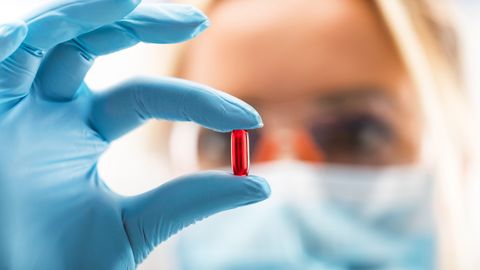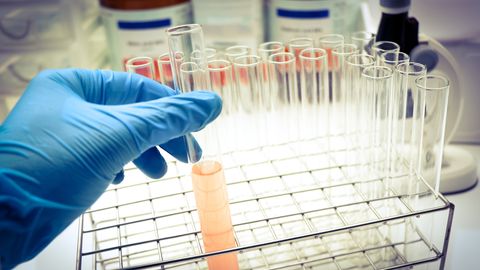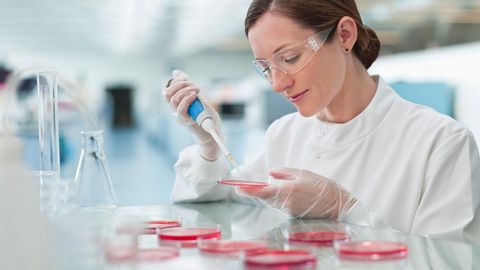Extracting Meaningful Data With High-Throughput Drug Discovery Approaches
High-throughput screening enables the rapid testing of thousands to millions of samples while eliminating molecules with undesirable properties.

Complete the form below to unlock access to ALL audio articles.
Discovering a novel drug can be a tedious and resource-intensive journey. The process usually starts by understanding the disease mechanisms and identifying suitable “targets”. Next is the identification of “hits”, which are molecules that elicit a desired activity towards the target in a screening activity. From hits that show a promising therapeutic activity, “leads”, or compounds of interest, are selected for further optimization.
High-throughput screening (HTS), virtual screening and fragment-based drug discovery are some popular screening approaches used to identify hits. This article will focus on the use of HTS approaches in drug discovery and discuss the latest developments in this area.
Navigating through the hits and leads
The drug discovery process can be roughly divided into four phases:
- Understanding disease mechanisms and identifying suitable drug targets
- Identifying hits
- Identifying lead molecules
- Optimization of leads
HTS is a drug screening approach used to identify hit molecules by screening samples against the desired targets. Hits are the starting point for drug discovery, which are then carried forward to identify leads.
Hits identified through HTS are configured for delivery, metabolism and pharmacokinetics to locate leads. These leads are further optimized to curate a drug product with the desired metabolism and pharmacokinetic properties.
HTS, being an automated approach, allows the swift screening of thousands to millions of samples in a short period of time while eliminating molecules with undesirable properties. This in turn reduces the total time invested in the entire drug discovery process.
HTS involves a series of steps including target identification, assay development, library screening and compound management. One of the key requirements in HTS is a large and diverse compound library, which allows the screening of thousands of activities in every round.
HTS may involve cell-based assays or biochemical assays. In cell-based assays, entire biological pathways can be tested, whereas in biochemical assays only pre-defined steps can be investigated. Cell-based assays can be harnessed to study cell growth, cell differentiation and cell signaling pathways. It is also helpful to gain insight into the effect of small molecules and various growth conditions on the cell. Second messenger assays, yeast complementation assays, reporter gene assays and cell proliferation assays are some examples of cell-based assays for HTS. Though cell-based assays are beneficial, they are not an option when knowledge regarding the target and mechanism of action is required. Biochemical assays are carried out in competition format and may involve measuring the ligand-binding affinity or enzyme-inhibition potential of the target of interest. The results are generally measured through absorption, luminescence or fluorescence. Fluorescence resonance energy transfer, fluorescence polarization, homogeneous time-resolved fluorescence, fluorescence correlation spectroscopy and fluorescence intensity distribution analysis are examples of biochemical assay techniques.
Decoding the latest trends
As with any technology, HTS approaches have undergone tremendous progress in the last few years. Dr. Paige N. Vinson, director of the Southern Research High-Throughput Screening Center, explains the latest trends: “I am seeing high-throughput processes being applied to more complex in vitro models such as 3D cell culture models (e.g., organoids and spheroids). These may or may not be the primary screening assay, but the ability to screen more compounds in these translational models means that there is less risk of ‘missing’ interesting compounds. I think the mantra of ‘screen all the compounds’ is being displaced to some degree by a more selective approach to help ensure that meaningful data are the result.”
Dr. Simon Mathien, manager of the High-Throughput Screening Core Facility at the Université de Montréal, says: “HTS is evolving towards more complex approaches and models, most notably with the now widespread use of high-content imaging and increased popularity of more complex models such as 3D cell culture, patient-derived organoids or even organ-on-a-chip and ex vivo culture systems.”
Artificial intelligence in HTS
The hit rates using conventional HTS approaches and large compound libraries typically can be low, resulting in the loss of enormous amounts of time, money and effort. To overcome this challenge, artificial intelligence (AI) technologies such as machine learning methods have been explored and the use of such advanced technologies has resulted in remarkable progress in the field of HTS.
“As for many other fields, AI and machine learning are profoundly changing the way we work in HTS. First, it impacts data treatment and analysis, but it can even change the purpose of HTS. Now, the goal may not only be to find hits for drug discovery programs but also to generate data to feed machine learning algorithms, aimed at designing new drug candidates,” Mathien notes.
Vinson adds, “AI touches every part of the drug discovery process and HTS is no exception. Like many other fields, the AI models used to predict compound activities rapidly advance as the datasets become richer and inform the model. In HTS, this results in an iterative screening process where hits from a vast virtual screen are confirmed experimentally, with results feeding back into the AI model for continuous refinement. One can imagine the hits from a virtual screen being sent to an automated platform for compound preparation and experimental data being analyzed and applied to the model in real time, resulting in a streamlined screening process. A sophisticated data infrastructure, advanced robotics and a massive compound library would be needed to successfully implement such a process. Therefore, scale is also essential to justify the investment. That’s not to say small operations cannot benefit from AI – I think most of the value comes from the resulting data, not the robotics.”
Instead of screening the full compound library, an iterative approach can be used to select potential hits. In an iterative approach, compounds are screened in batches. Machine learning is used to fill up each batch, comprised of the best compounds based on the preceding results. An iterative approach can help reduce the number of compounds screened as well as improve the hit rate.
Rahman et al. showed that screening compounds using a machine learning approach can be used for compound prioritization and improving the typical hit rate of drug discovery. The team trained a machine learning model with properties of compounds that exhibited antibacterial activity against Burkholderia cenocepacia, an antibiotic-resistant bacterium. The machine learning model was used to predict antibacterial activity in a library of US Food and Drug Administration (FDA)-approved compounds and natural products. The researchers found that the machine learning approach increases the hit rate by at least 14-fold.
A more structured and focused approach for HTS
HTS offers a more focused approach to screening potential compounds by swiftly screening a plethora of samples and eliminating undesirable compounds at the same time. Compared to other screening approaches, HTS can be more easily adapted to complex systems such as high-content screening and complex 3D models. It can also be used in parallel to other screening approaches such as virtual screening.








